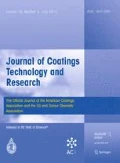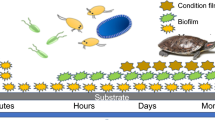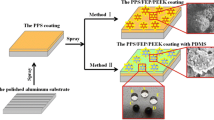Abstract
The degradation of corrosion preventative coatings contributes to the high cost and time requirements for maintaining structures in harsh environments. However, the development of new hydrophobic coatings holds the promise of extending the usable life of structures in marine environments. In this work, we quantify the barrier properties and corrosion resistance of two novel highly hydrophobic polysiloxane formulations and the legacy silicone alkyd topcoat used on the topside of Navy’s ships, all with haze gray pigmentation. Based on FTIR-ATR and EIS measurements of the pristine coatings, both the single- (1K) and the two-component (2K) polysiloxane provide significantly improved barrier characteristics (lower water diffusion coefficient and capacitance) than the silicone alkyd. These results were confirmed through a 3-month-long immersion corrosion test, which also showed that the 1K and 2K polysiloxane coatings had comparable degradation characteristic and remained highly hydrophobic.







Similar content being viewed by others
References
Huffmann, L, Hower, H, “The Emergence of Polysiloxanes and Protective Coatings.” J. Prot. Coat. Linings., 20 5–9 (2003)
Lockwood, P, Cloutier, R, Kinee, D, “Use of Polysiloxane Coatings for Topside Applications on US Navy Ships.” Nav. Eng. J., 128 65–70 (2016)
Andrews, AF, “Polysiloxane Topcoats—A Step Too Far?” Corros. 2005, NACE International, 2005.
Witucki, G, “Next Generation Polysiloxane Hybrid Coatings.” Polym. Paint Colour J., 11 22–24 (2012)
Axelsen, SB, Johnsen, R, Knudsen, OØ, “Internal Stress in Polysiloxane Topcoats.” Corrosion, 66 65005 (2010)
Axelsen, SB, Johnsen, R, Knudsen, OØ, “Adhesion Properties of Polysiloxane Topcoats.” Corrosion, 66 125003 (2010)
Axelsen, SB, Johnsen, R, Knudsen, OØ, “Mechanical Properties of Polysiloxane Topcoats.” Corrosion, 66 65006 (2010)
MIL-PRF-24635E Performance Specification, “Coating Systems, Weather-Resistant, Exterior Use.” (2009)
Kaesler, K, “Polysiloxane Coatings for Corrosion Protection.” In: Khanna, A (ed.) High-Performance Organic Coatings, 1st ed., pp. 225–246. Woodhead Publishing, Cambridge, England (2008)
Metroke, TL, Parkhill, RL, Knobbe, ET, “Passivation of Metal Alloys using Sol–Gel-Derived Materials—A Review.” Prog. Org. Coat., 41 233–238 (2001)
Wang, Y, Liu, J, Li, M, Wang, Q, Chen, Q, “The Icephobicity Comparison of Polysiloxane Modified Hydrophobic and Superhydrophobic Surfaces Under Condensing Environments.” Appl. Surf. Sci., 385 472–480 (2016)
Iezzi, EB, Martin, J, Tagert, J, Slebodnick, P, Wegand, J, Lemieux, E, Spicer, C, “Advanced 2K and 1K Topside Coatings for the U.S. Navy.” DoD-Allied Nations Tech. Corros. Conf. (2011)
Iezzi, EB, “Single-Component Moisture-Curable Coatings Based on N-Substituted Urea Polymers with Extended Chains and Terminal Alkoxysilanes.” US Patent 9139753, 2015.
Iezzi, EB, “Single-Component Coating Having Alkoxysilane-Terminated N-Substituted Urea Resins.” US Patent 9221942, 2015.
Hodson, J, Lander, JA, “The Analysis of Cured Paint Media and a Study of the Weathering of Alkyd Paints by FTIR/PAS.” Polymer, 28 251–256 (1987)
Gonalves, GS, Baldissera, AF, Rodrigues, LF, Martini, EMA, Ferreira, CA, “Alkyd Coatings Containing Polyanilines for Corrosion Protection of Mild Steel.” Synth. Met., 161 313–323 (2011)
Araujo, WS, Margarit, ICP, Mattos, OR, Fragata, FL, De Lima-Neto, P, “Corrosion Aspects of Alkyd Paints Modified with Linseed and Soy Oils.” Electrochim. Acta, 55 6204–6211 (2010)
Perrin, FX, Irigoyen, M, Aragon, E, Vernet, JL, “Evaluation of Accelerated Weathering Tests for Three Paint Systems: A Comparative Study of Their Aging Behaviour.” Polym. Degrad. Stab., 72 115–124 (2001)
Cadena, F, Irusta, L, Fernandez-Berridi, MJ, “Performance Evaluation of Alkyd Coatings for Corrosion Protection in Urban and Industrial Environments.” Prog. Org. Coat., 76 1273–1278 (2013)
Shi, H, Liu, F, Han, E, Wei, Y, “Effects of Nano Pigments on the Corrosion Resistance of Alkyd Coating.” J. Mater. Sci. Technol., 23 551–558 (2007)
Hansal, WEG, Hansal, S, Pölzler, M, Kornherr, A, Zifferer, G, Nauer, GE, “Investigation of Polysiloxane Coatings as Corrosion Inhibitors of Zinc Surfaces.” Surf. Coat. Technol., 200 3056–3063 (2006)
Sarmento, VHV, Schiavetto, MG, Hammer, P, Benedetti, AV, Fugivara, CS, Suegama, PH, Pulcinelli, SH, Santilli, CV, “Corrosion Protection of Stainless Steel by Polysiloxane Hybrid Coatings Prepared Using the Sol–Gel Process.” Surf. Coat. Technol., 204 2689–2701 (2010)
Wu, KH, Chao, CM, Yeh, TF, Chang, TC, “Thermal Stability and Corrosion Resistance of Polysiloxane Coatings on 2024-T3 and 6061-T6 Aluminum Alloy.” Surf. Coat. Technol., 201 5782–5788 (2007)
Perälä, M, Tikkanen, S, “Composition to be Used in Paints.” US Patent US7351783, 2008.
Yuan, X, Yue, ZF, Chen, X, Wen, SF, Li, L, Feng, T, “EIS Study of Effective Capacitance and Water Uptake Behaviors of Silicone-Epoxy Hybrid Coatings on Mild Steel.” Prog. Org. Coatings., 86 41–48 (2015)
ASTM, “Standard Guide for Laboratory Immersion Corrosion Testing of Metals.” ASTM Int., G31–12a 1–10 (2012)
Rykaczewski, K, Mieritz, DG, Liu, M, Ma, Y, Iezzi, EB, Sun, X, Wang, LP, Solanki, KN, Seo, D-K, Wang, RY, “Far-Reaching Geometrical Artefacts due to Thermal Decomposition of Polymeric Coatings Around Focused Ion Beam Milled Pigment Particles.” J. Microsc., 262 316–325 (2016)
Nguyen, T, Bentz, D, Byrd, E, “Method for Measuring Water Diffusion in a Coating Applied to a Substrate.” J. Coat. Technol., 67 37–46 (1995)
Linossier, I, Gaillard, F, Romand, M, Feller, J, “Measuring Water Diffusion in Polymer Films on the Substrate by Internal Reflection Fourier Transform Infrared Spectroscopy.” J. Appl. Polym. Sci., 66 2465–2473 (1997)
Philippe, L, Sammon, C, Lyon, SB, Yarwood, J, “An FTIR/ATR In Situ Study of Sorption and Transport in Corrosion Protective Organic Coatings: Paper 2. The Effects of Temperature and Isotopic Dilution.” Prog. Org. Coat., 49 315–323 (2004)
Philippe, L, Sammon, C, Lyon, SB, Yarwood, J, “An FTIR/ATR In Situ Study of Sorption and Transport in Corrosion Protective Organic Coatings 1. Water Sorption and the Role of Inhibitor Anions.” Prog. Org. Coat., 49 302–314 (2004)
Ohman, M, Persson, D, “An Integrated In Situ ATR-FTIR and EIS Set-Up to Study Buried Metal-Polymer Interfaces Exposed to an Electrolyte Solution.” Electrochim. Acta, 52 5159–5171 (2007)
Hu, JM, Zhang, JQ, Cao, CN, “Determination of Water Uptake and Diffusion of Cl-ion in Epoxy Primer on Aluminum Alloys in NaCl Solution by Electrochemical Impedance Spectroscopy.” Prog. Org. Coat., 46 273–279 (2003)
Amirudin, DTA, Amirudin, A, Thierry, D, “Application of Electrochemical Impedance Spectroscopy to Study the Degradation of Polymer-Coated Metals.” Prog. Org. Coat., 26 1–28 (1995)
Bierwagen, G, Tallman, D, Li, J, He, L, Jeffcoate, C, “EIS Studies of Coated Metals in Accelerated Exposure.” Prog. Org. Coat., 46 148–157 (2003)
Hinderliter, BR, Croll, SG, Tallman, DE, Su, Q, Bierwagen, GP, “Interpretation of EIS Data from Accelerated Exposure of Coated Metals Based on Modeling of Coating Physical Properties.” Electrochim. Acta, 51 4505–4515 (2006)
Floyd, FL, Avudaiappan, S, Gibson, J, Mehta, B, Smith, P, Provder, T, Escarsega, J, “Using Electrochemical Impedance Spectroscopy to Predict the Corrosion Resistance of Unexposed Coated Metal Panels.” Prog. Org. Coat., 66 8–34 (2009)
Ploeger, R, Musso, S, Chiantore, O, “Contact Angle Measurements to Determine the Rate of Surface Oxidation of Artists’ Alkyd Paints During Accelerated Photo-Ageing.” Prog. Org. Coat., 65 77–83 (2009)
Damle, VG, Sun, X, Rykaczewski, K, “Can Metal Matrix-Hydrophobic Nanoparticle Composites Enhance Water Condensation by Promoting the Dropwise Mode?” Adv. Mater. Interfaces, 2 1500202 (2015)
De Gennes, P-G, Brochard-Wyart, F, Quéré, D, Capillarity and Wetting Phenomena: Drops, Bubbles, Pearls, Waves. Springer Science & Business Media, Berlin (2013)
Acknowledgments
KR, KNS, and LPW acknowledge funding from the US Department of Defense under the Technical Corrosion Collaboration (TCC) Program through Grant No. FA7000-14-2-0015. This TCC grant is administered by the US Air Force Academy. The authors acknowledge the use of facilities at the LeRoy Eyring Center for Solid State Science at Arizona State University.
Author information
Authors and Affiliations
Corresponding authors
Additional information
X. Sun and S. Turnage have contributed equally to this work.
Electronic supplementary material
Below is the link to the electronic supplementary material.
Rights and permissions
About this article
Cite this article
Sun, X., Turnage, S., Iezzi, E.B. et al. Water permeation and corrosion resistance of single- and two-component hydrophobic polysiloxane barrier coatings. J Coat Technol Res 14, 1247–1258 (2017). https://doi.org/10.1007/s11998-017-9918-5
Published:
Issue Date:
DOI: https://doi.org/10.1007/s11998-017-9918-5




